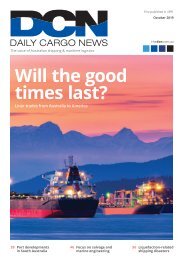DCN December Edition 2019
You also want an ePaper? Increase the reach of your titles
YUMPU automatically turns print PDFs into web optimized ePapers that Google loves.
INDUSTRY ANALYTICS<br />
Container volumes contract<br />
for the second time in a decade<br />
The Australian Competition & Consumer Commission has released its 2018-19<br />
monitoring report for container stevedoring. Here are some key excerpts<br />
A WEAKENING ECONOMY<br />
COMPETITION EVIDENT<br />
and since the third stevedores entered the<br />
dampened demand for stevedoring services<br />
Competition has resulted in further shifts<br />
industry at the east coast ports. Revenue<br />
in 2018–19, with growth rates far below<br />
in the stevedores’ shares of national lifts.<br />
per lift grew by 1.8% to $268.50.<br />
those reported in the previous year,<br />
Most notable was the share of lifts handled<br />
The industry generated $167m in revenue<br />
according to the Container stevedoring<br />
by DP World falling from 44.4% in 2017–18<br />
from infrastructure charges in 2018–19,<br />
monitoring report 2018–19.<br />
to just 39.1% in 2018–19. However, fellow<br />
an increase of 63% from 2017–18. After<br />
The number of lifts made by the<br />
incumbent stevedore Patrick fared much<br />
DP World’s decision to increase charges in<br />
international container stevedores fell for<br />
better during the year, with its share of<br />
Melbourne from around $49 to $85 from<br />
only the second time in the last decade. The<br />
national lifts increasing from 41.5% to<br />
1 January <strong>2019</strong>, Patrick and VICT followed<br />
stevedores reported 5.11m lifts in 2018–19,<br />
43.5%, after it reported having won several<br />
with increases of their own. Patrick now<br />
down 0.5% from the previous year. Lifts<br />
new contracts during the period.<br />
has the highest charges in Sydney ($77.50)<br />
of full containers fell by 4.9% while empty<br />
The dominance of the two largest<br />
and Brisbane ($71.50).<br />
containers increased by 14.6%.<br />
stevedores was diluted further in 2018–19.<br />
Industry volumes were slightly better<br />
The combined share of lifts by the two<br />
INDUSTRY-WIDE PROFITABILITY<br />
when measured on a TEU basis, as cargo<br />
firms represented 82.6% of national lifts,<br />
REMAINS LOW<br />
owners continued to increasingly adopt<br />
the lowest on record.<br />
Some industry profitability indicators fell<br />
40-foot containers instead of 20-foot<br />
After just two years of operations, VICT<br />
in 2018–19, continuing the trend reported<br />
containers. The container terminals reported<br />
has now established itself as an effective<br />
in recent years. Industry operating profit<br />
handling a combined 7.88m TEU in 2018–19.<br />
competitor in Melbourne. Its share of lifts<br />
fell by 4.7% to $81.3m and operating profit<br />
This represented growth of 0.2%, the second<br />
in Melbourne more than doubled to around<br />
margin fell slightly to 5.9%. While the<br />
lowest rate over the past ten years.<br />
15% after it won several shipping services<br />
industry’s return on tangible assets was<br />
The slowdown in container volume<br />
during the period. On the other hand,<br />
unchanged at 3.8%, this figure has fallen<br />
growth reflects weakening economic<br />
Hutchison’s share of total lifts in Brisbane<br />
from a high of 27.8% in 2011–12.<br />
activity in goods distribution industries<br />
and Sydney remained at 13%.<br />
While stevedores have had to face<br />
such as retail and manufacturing. In<br />
growing bargaining power of the shipping<br />
addition, the drought in eastern Australia<br />
HIGHER INFRASTRUCTURE CHARGES<br />
lines in recent years, the significant fall<br />
and floods in Queensland negatively<br />
Higher infrastructure charges helped<br />
in this latter figure also represents a<br />
impacted on volumes of various export<br />
commodities such as grain, hay and cotton.<br />
to drive growth in unit revenues for the<br />
stevedores for the first time since 2011–12<br />
much larger asset base due to the new<br />
container terminals in Brisbane, Sydney and<br />
Patrick<br />
60 <strong>December</strong> <strong>2019</strong><br />
thedcn.com.au
















